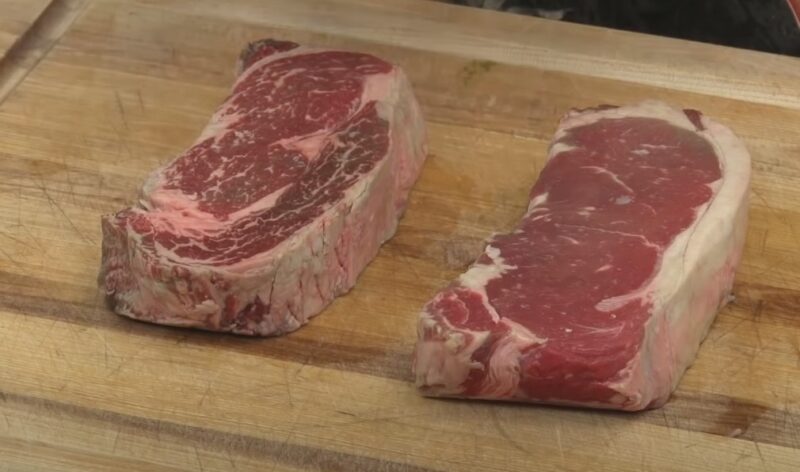When it comes to indulging in a mouthwatering steak, the choice between Ribeye and New York Strip can be a tough one. Both cuts are beloved for their delicious flavors and tender textures, but they do have their differences. To help you make an informed decision, let’s explore the characteristics and cooking methods of these two popular steaks.
Key Takeaways:
- Ribeye steak is known for its rich flavor, smooth texture, and generous marbling
- New York Strip steak has a tighter texture and slightly less marbling compared to Ribeye
- Ribeye is best cooked using a two-zone grilling method or reverse sear
- New York Strip is best cooked hot and fast
- New York Strip steak is slightly more affordable than Ribeye
Understanding Ribeye Steak
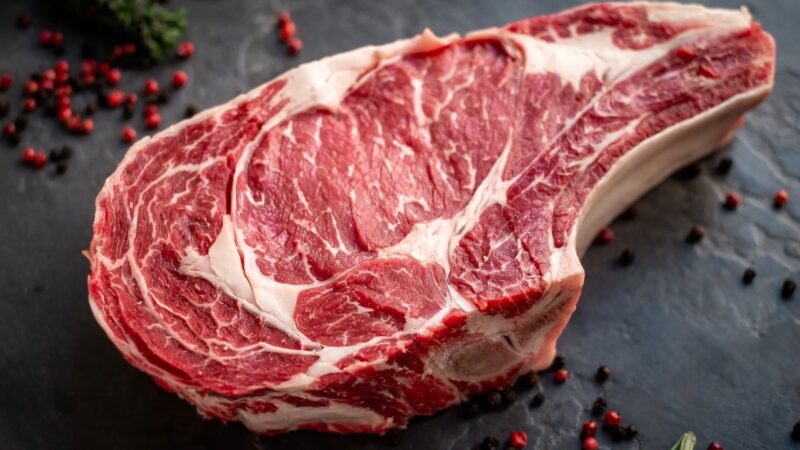
Ribeye steak, with its succulent flavor and luxurious marbling, is a true delight for steak lovers. This cut comes from the longissimus dorsi muscle, which is located in the upper ribcage area of the cow. It is known for its rich, buttery taste and smooth, melt-in-your-mouth texture.
When it comes to the different types of Ribeye steaks available, three popular variations stand out. The prime ribeye is the highest grade, offering exceptional marbling and tenderness. A boneless ribeye is a bone-free option, perfect for those who prefer a more convenient dining experience. Lastly, the USDA ribeye is certified by the United States Department of Agriculture, ensuring quality and consistency.
The Characteristics of Ribeye Steak:
- Rich flavor
- Smooth, melt-in-your-mouth texture
- Generous marbling for added juiciness
- Available as prime ribeye, boneless ribeye, and USDA ribeye
When it comes to cooking Ribeye steak, two popular methods are widely used. The two-zone grilling method involves searing the steak over high heat and then moving it to indirect heat to cook it through to the desired doneness. This method helps retain the steak’s tenderness and prevents overcooking. Another technique is the reverse sear method, where the steak is first cooked at a low temperature in the oven and then finished with a quick sear in a hot pan or grill. This technique ensures a perfectly cooked and flavorful Ribeye steak every time.
| Ribeye Steak | Characteristics |
|---|---|
| Flavor | Rich and buttery |
| Texture | Melt-in-your-mouth tenderness |
| Cooking Method | Two-zone grilling or reverse sear |
Cooking Ribeye Steak
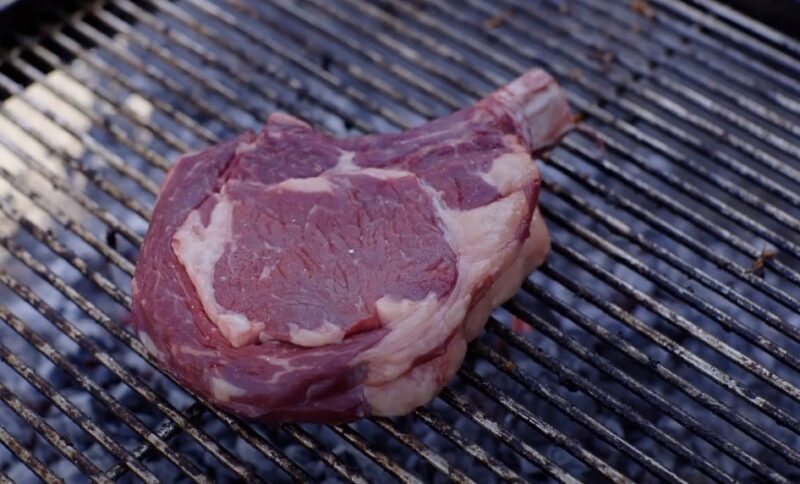
Cooking a Ribeye steak to perfection requires the right technique to unleash its full potential. With its rich flavor and generous marbling, the Ribeye is a favorite among steak enthusiasts. To ensure a tender and juicy result, grilling is the preferred cooking method for Ribeye steaks.
One popular technique is the two-zone grilling method. This involves creating a hot direct heat zone and a cooler indirect heat zone on the grill. Start by searing the steak over the direct heat to achieve a beautiful crust. Then, move the steak to the indirect heat to continue cooking until it reaches the desired doneness. This method allows for even cooking and prevents the steak from becoming overcooked on the outside while still raw in the center.
Another technique that works wonders for Ribeye steaks is the reverse sear method. This method involves cooking the steak at a low temperature in an oven or on indirect heat on the grill until it reaches an internal temperature of around 10-15 degrees below the desired doneness. Then, finish the steak by searing it over high heat for a few minutes on each side. This method results in a perfectly cooked steak with a beautiful crust and a tender, juicy interior.
Table: Recommended Cooking Temperatures for Ribeye Steak
| Doneness | Internal Temperature |
|---|---|
| Rare | 120-125°F (49-52°C) |
| Medium Rare | 130-135°F (54-57°C) |
| Medium | 140-145°F (60-63°C) |
| Medium Well | 150-155°F (66-68°C) |
| Well Done | 160°F (71°C) and above |
When grilling Ribeye steaks, it’s essential to let them rest for a few minutes before slicing. This allows the juices to redistribute throughout the meat, resulting in a more flavorful and tender steak. Serve the Ribeye steak with your favorite side dishes or sauces to complement its rich, beefy flavor.
Exploring New York Strip Steak
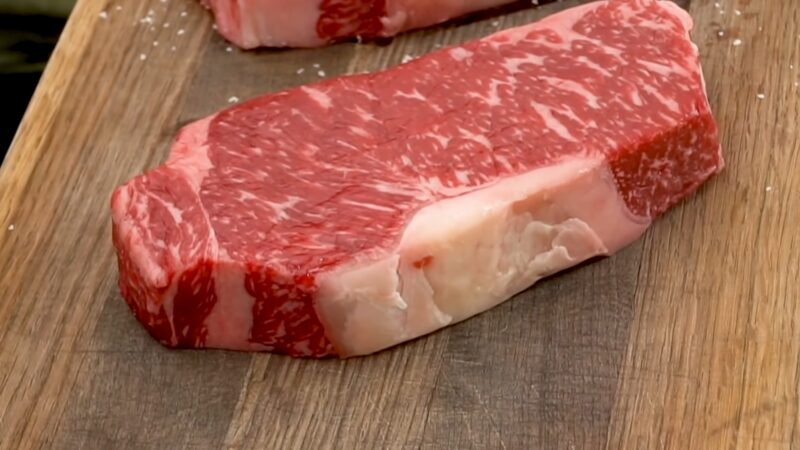
New York Strip steak, known for its firm texture and savory flavor, is a favorite among steak enthusiasts. This cut comes from the longissimus dorsi muscle, similar to the Ribeye, but has distinct characteristics that set it apart. With less internal marbling compared to Ribeye, the New York Strip offers a slightly leaner option with a tighter texture and a more pronounced beefy taste.
Cooking a New York Strip steak is a delight, as it lends itself well to the hot and fast cooking method. By searing it quickly over high heat, you can achieve a deliciously caramelized exterior while maintaining the steak’s tenderness and juiciness. Whether you prefer grilling, pan-searing, or broiling, the New York Strip steak responds well to these techniques, offering a mouthwatering dining experience.
To fully appreciate the flavors and textures of New York Strip steak, it’s best to pair it with simple seasonings that enhance its natural beefiness. A sprinkle of salt and pepper, along with a touch of garlic powder or your favorite steak rub, can bring out the savory and robust flavors of this classic cut.
Notable features of New York Strip Steak:
- Firm texture
- Savory flavor
- Less internal marbling
| Steak Cut | Texture | Marbling | Price |
|---|---|---|---|
| New York Strip | Firm | Less | Slightly more affordable than Ribeye |
Cooking New York Strip Steak
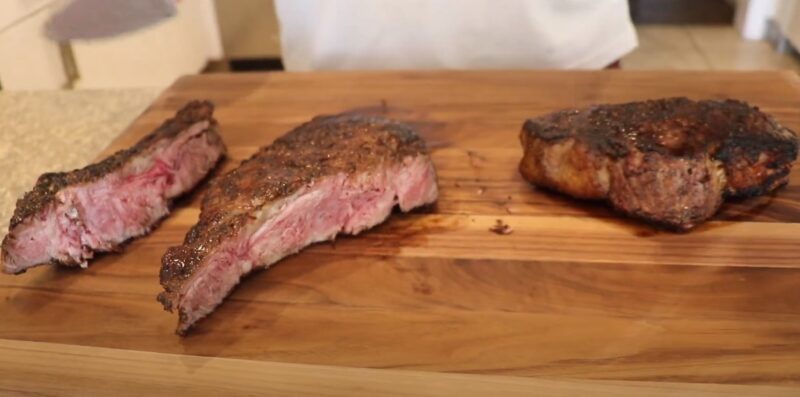
Cooking a New York Strip steak to perfection requires a straightforward yet precise approach. This cut of beef, known for its tight texture and slightly less marbling compared to the Ribeye, demands attention and careful cooking techniques to bring out its full potential.
To start, it’s essential to choose a high-quality New York Strip steak and let it come to room temperature before cooking. This allows for even cooking and helps retain the steak’s natural juices.
For optimal results, it is recommended to season the steak with salt and pepper just before cooking to enhance its natural flavors. Heat a cast-iron skillet or grill to high heat, ensuring it is preheated to prevent sticking and promote a beautiful sear.
Place the steak onto the hot cooking surface and resist the temptation to flip it too soon. Allow the steak to cook for about 4-5 minutes on each side for medium-rare, adjusting the time based on your desired level of doneness. Remember to use a meat thermometer to ensure the steak reaches your desired internal temperature.
| Internal Temperature | Level of Doneness |
|---|---|
| 130°F (54°C) | Medium-rare |
| 135°F (57°C) | Medium |
| 145°F (63°C) | Medium-well |
“The key to a perfectly cooked New York Strip steak lies in achieving a deliciously seared exterior while maintaining the steak’s tender and juicy interior. Take your time, and let the steak rest for a few minutes before serving to allow the juices to redistribute and ensure a mouthwatering dining experience,” says Chef Gordon Ramsay.
Whether you choose to accompany your New York Strip steak with classic mashed potatoes, grilled vegetables, or a side salad, this delectable cut of beef is sure to satisfy your taste buds. Enjoy the robust, beefy flavors and the satisfying chew of this beloved steak.
Comparing Ribeye and New York Strip Steak
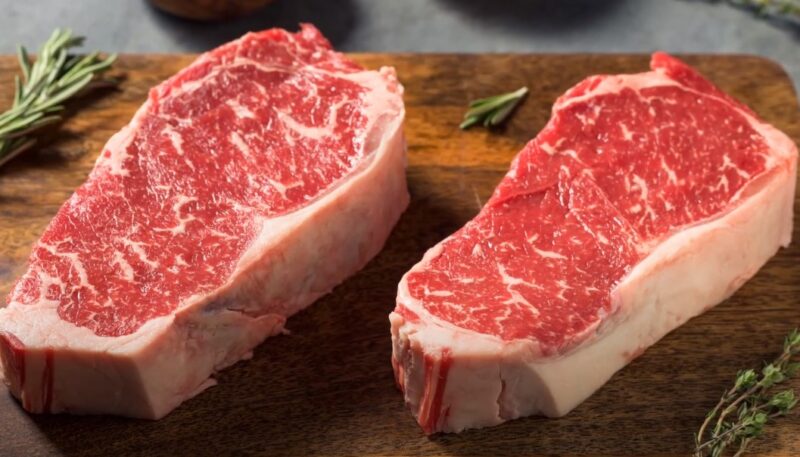
As you weigh the options between Ribeye and New York Strip steak, it’s essential to consider their unique qualities and how they align with your preferences. Both cuts come from the longissimus dorsi muscle, but they have distinct characteristics that set them apart.
Flavor and Texture
The Ribeye is renowned for its rich flavor and smooth texture. It boasts abundant marbling, which contributes to its juicy and tender nature. On the other hand, the New York Strip has less marbling and a tighter texture, giving it a slightly chewier consistency. These differences in flavor and texture provide a range of culinary experiences to suit various preferences.
Cooking Techniques
When it comes to cooking methods, the Ribeye is typically prepared using a two-zone grilling method or a reverse sear. These techniques ensure that the steak is cooked to perfection, with a nicely charred exterior and a tender, juicy interior. On the other hand, the New York Strip is best cooked hot and fast, allowing for a flavorful sear while preserving its tenderness.
Price Considerations
In terms of price, the New York Strip tends to be slightly more budget-friendly compared to the Ribeye. This affordability factor may be a determining factor for some individuals when deciding between the two cuts. However, it’s important to note that the Ribeye’s exceptional flavor and texture make it a popular choice, despite its higher price point.
Both Ribeye and New York Strip steaks are delicious options that offer unique flavor and texture profiles. Ultimately, the choice between them comes down to personal preference. Consider your desired taste experience, cooking style, and budget to make the decision that best suits your individual palate.
Exploring the Flavor Profiles
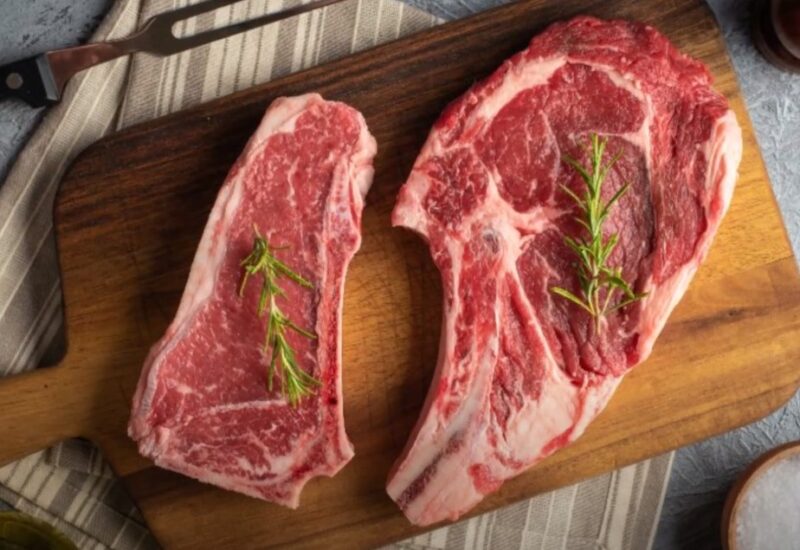
The flavor profiles of Ribeye and New York Strip steak are as distinct as the cuts themselves. Ribeye steak is known for its rich, buttery taste, thanks to its abundant marbling. With every bite, you’ll experience a burst of savory flavors that melt in your mouth. The generous fat content ensures a luscious and succulent steak that is highly sought after by steak connoisseurs.
On the other hand, New York Strip steak offers a bold and beefy flavor. Its tighter texture gives it a slightly firmer bite, providing a satisfying chew that steak lovers appreciate. While it has less marbling compared to Ribeye, it boasts strong, robust flavors that deliver a hearty and meaty taste experience.
Whether you prefer the velvety tenderness of the Ribeye or the robust meatiness of the New York Strip, both steaks promise an indulgent eating experience that will leave your taste buds craving for more.
| Ribeye Steak | New York Strip Steak |
|---|---|
| Rich, buttery taste | Bold and beefy flavors |
| Smooth texture | Tighter texture |
| Abundant marbling | Less marbling |
The Textural Differences
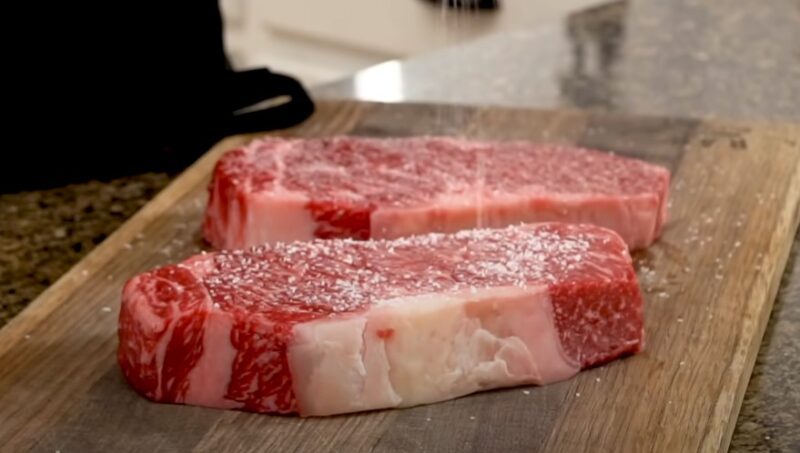
While both Ribeye and New York Strip steak are incredibly satisfying, their textures offer unique experiences. The Ribeye, with its generous marbling, boasts a melt-in-your-mouth tenderness that steak lovers adore. As you take each bite, the marbled fat gently dissolves, creating a luscious and buttery mouthfeel. The Ribeye’s smooth texture enhances the eating experience, making it a favorite among steak connoisseurs.
In contrast, the New York Strip steak offers a tighter texture with slightly less marbling. This results in a steak that is slightly chewier, providing a satisfying resistance when you bite into it. The meaty and firm texture of the New York Strip gives it a substantial feel, allowing you to savor each mouthful. If you enjoy a steak with a bit more bite and a meatier sensation, the New York Strip will satisfy your cravings.
When it comes to cooking techniques, the Ribeye’s tender texture benefits from slow cooking methods. The two-zone grilling method creates an optimal balance of searing and indirect heat, allowing the marbling to render and infuse the meat with flavor. Alternatively, the reverse sear technique, which involves slow cooking the steak first and then searing it at high heat, ensures a tender and juicy result for this indulgent cut.
| Ribeye | New York Strip Steak | |
|---|---|---|
| Texture | Melt-in-your-mouth tenderness | Firm and slightly chewy |
| Marbling | Generous marbling | Less marbling |
| Cooking Technique | Two-zone grilling method or reverse sear | Hot and fast |
So, whether you prefer the buttery tenderness of the Ribeye or the meatier texture of the New York Strip, both steaks offer a delightful dining experience. Experiment with different cooking methods and seasonings to further enhance the unique characteristics of each cut. Ultimately, the choice between Ribeye and New York Strip steak boils down to personal preference, allowing you to indulge in the texture that brings you the most pleasure.
Considerations of Cooking Techniques
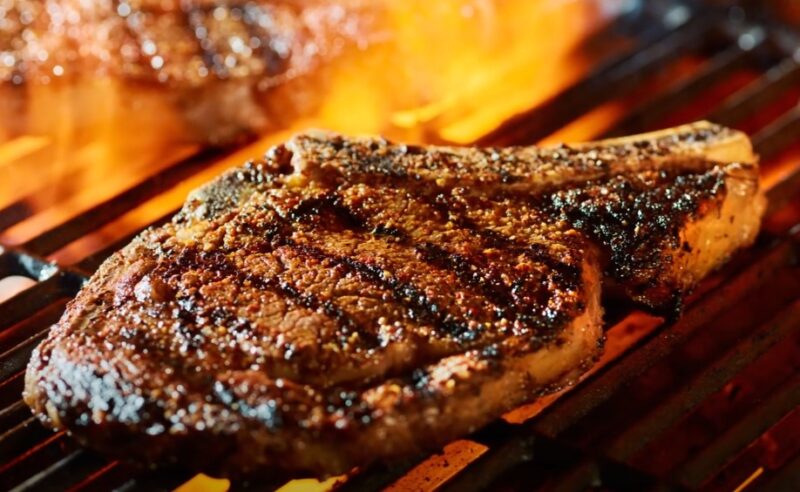
Cooking techniques play a significant role in bringing out the best in Ribeye and New York Strip steaks. These two cuts have different characteristics that require specific cooking methods to enhance their flavors and textures. For a tender and juicy Ribeye steak, the two-zone grilling method or reverse sear technique are highly recommended. The two-zone grilling method involves creating two heat zones on the grill to sear the steak over high heat and then finish it over indirect heat. This method allows for a perfectly cooked steak with a caramelized crust and a juicy interior.
On the other hand, the New York Strip steak is best cooked hot and fast. This means searing it on high heat for a short period of time to achieve a flavorful crust while keeping the interior tender. By cooking the New York Strip steak hot and fast, you can lock in the juices and prevent it from becoming tough.
When cooking either cut, it is important to let the steaks rest for a few minutes after cooking to allow the juices to redistribute throughout the meat, resulting in a more flavorful and tender steak. Additionally, using a meat thermometer to check for the desired internal temperature can help ensure that the steaks are cooked to perfection.
Now that you have a better understanding of the cooking techniques for Ribeye and New York Strip steaks, you can confidently prepare these delectable cuts of meat to impress your family and friends. The following table summarizes the recommended cooking techniques for each cut:
| Ribeye Steak | New York Strip Steak |
|---|---|
| Two-zone grilling method or reverse sear | Hot and fast cooking |
| Internal temperature: 130-135°F for medium-rare | Internal temperature: 135-140°F for medium-rare |
| Rest for 5-10 minutes before serving | Rest for 5-10 minutes before serving |
Price Comparison
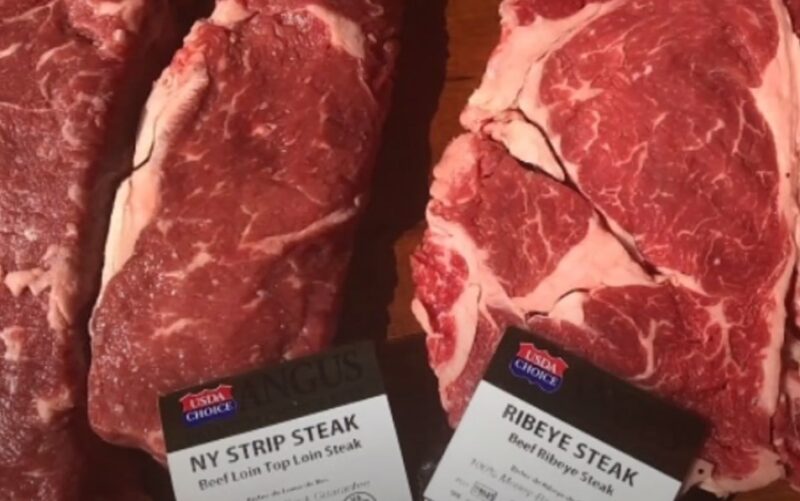
While indulging in a premium steak experience, it’s important to factor in the price. When comparing Ribeye and New York Strip steaks, there is a slight difference in cost. On average, the New York Strip is slightly more affordable than the Ribeye. This makes the New York Strip an enticing option for those looking to enjoy a delicious steak without breaking the bank.
However, it’s essential to note that the price differential between the two cuts can vary depending on factors such as the quality and grading of the meat, the region, and the specific cuts available at different establishments. It’s always a good idea to check with your local butcher or steak supplier for current pricing and availability.
Despite the difference in price, both Ribeye and New York Strip steaks offer exceptional taste and quality. Whether you choose the Ribeye for its rich flavor and generous marbling, or the New York Strip for its slightly leaner texture and affordability, you’ll be treated to a memorable dining experience.
| Steak Cut | Average Price per Pound |
|---|---|
| Ribeye | $15.99 |
| New York Strip | $13.99 |
Table: Average price per pound for Ribeye and New York Strip steaks
“Price is what you pay, value is what you get.” – Warren Buffett
As Warren Buffett’s quote suggests, the price of a steak should be considered in relation to the value it provides. Both Ribeye and New York Strip steaks offer exceptional flavors and can be prepared in a variety of mouthwatering ways. Whether you opt for the indulgence of a Ribeye or the affordability of a New York Strip, the satisfaction of a premium steak experience is guaranteed.
Making the Choice – Personal Preference
When making the final decision between Ribeye and New York Strip steak, trust your instincts and preferences. Both cuts offer their own distinct flavor and texture profiles, ensuring a delightful dining experience. The choice ultimately comes down to what you enjoy most in a steak.
If you crave a steak that is rich, buttery, and melts in your mouth, then the Ribeye is the perfect choice for you. Known for its generous marbling and smooth texture, the Ribeye delivers a succulent and tender bite with every mouthful. The prime ribeye, boneless ribeye, and USDA ribeye are all excellent options to explore.
On the other hand, if you prefer a steak with a tighter texture and a slightly chewier consistency, the New York Strip steak will satisfy your cravings. This cut offers a bold, beefy flavor that is sure to please. It is also more budget-friendly compared to the Ribeye, making it an attractive option for steak lovers.
| Ribeye | New York Strip Steak |
|---|---|
| Rich, buttery flavor | Bold, beefy flavor |
| Generous marbling | Less marbling |
| Smooth texture | Tighter texture |
| Best cooked using two-zone grilling method or reverse sear | Best cooked hot and fast |
| Slightly higher price | More affordable |
Ultimately, whether you prefer the tender and juicy Ribeye or the slightly chewier New York Strip steak is a matter of personal taste. Trust your senses and go with what your taste buds desire. Whether it’s the rich flavor and smooth texture of a Ribeye or the bold, beefy bite of a New York Strip steak, both options are sure to satisfy your steak cravings in their own unique way.
FAQ
Are Ribeye and New York Strip steaks different cuts of meat?
Yes, they come from the same longissimus dorsi muscle, but the Ribeye has more internal marbling and a richer flavor compared to the New York Strip.
What is the best way to cook Ribeye steak?
Ribeye steaks can be cooked using the two-zone grilling method or the reverse sear technique to achieve optimal tenderness and juiciness.
How does the texture of New York Strip steak differ from Ribeye?
New York Strip steak has a tighter texture and a slightly chewier consistency compared to the melt-in-your-mouth tenderness of Ribeye.
Is New York Strip steak more affordable than Ribeye?
Yes, generally speaking, New York Strip steak tends to be slightly more affordable than Ribeye.
How do I choose between Ribeye and New York Strip steak?
It ultimately comes down to personal preference. Consider the flavor, texture, cooking methods, and price to decide which steak best suits your taste.
Closing Thoughts
Whether you opt for the richly marbled Ribeye or the robust New York Strip, both promise a delectable steak experience. Ribeye is known for its juicy, melt-in-the-mouth texture, while the New York Strip offers a bolder taste with a firmer bite.
Each cut requires specific cooking techniques: Ribeye excels with reverse searing, whereas the New York Strip benefits from a quick, high-heat sear. Price-wise, the New York Strip is usually more wallet-friendly.
In the end, choosing between the two boils down to individual taste and budget, but either choice guarantees a delightful culinary experience.

